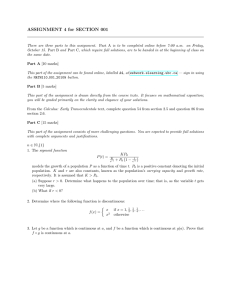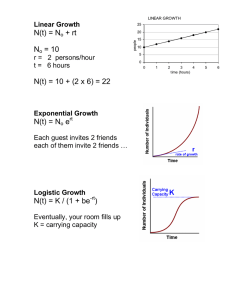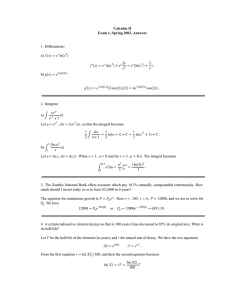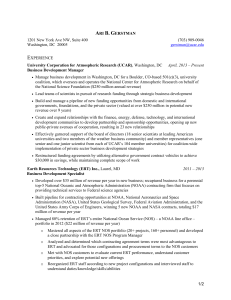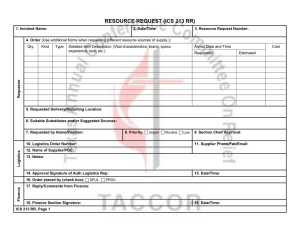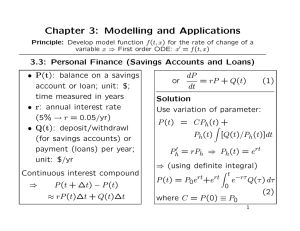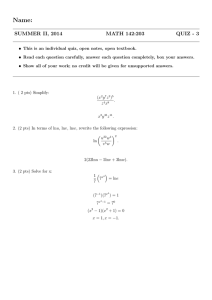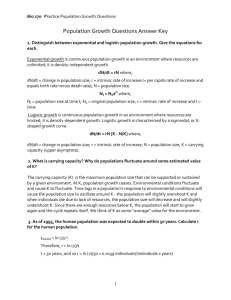Accounting for spatially variable resolution in electrical resistivity
advertisement
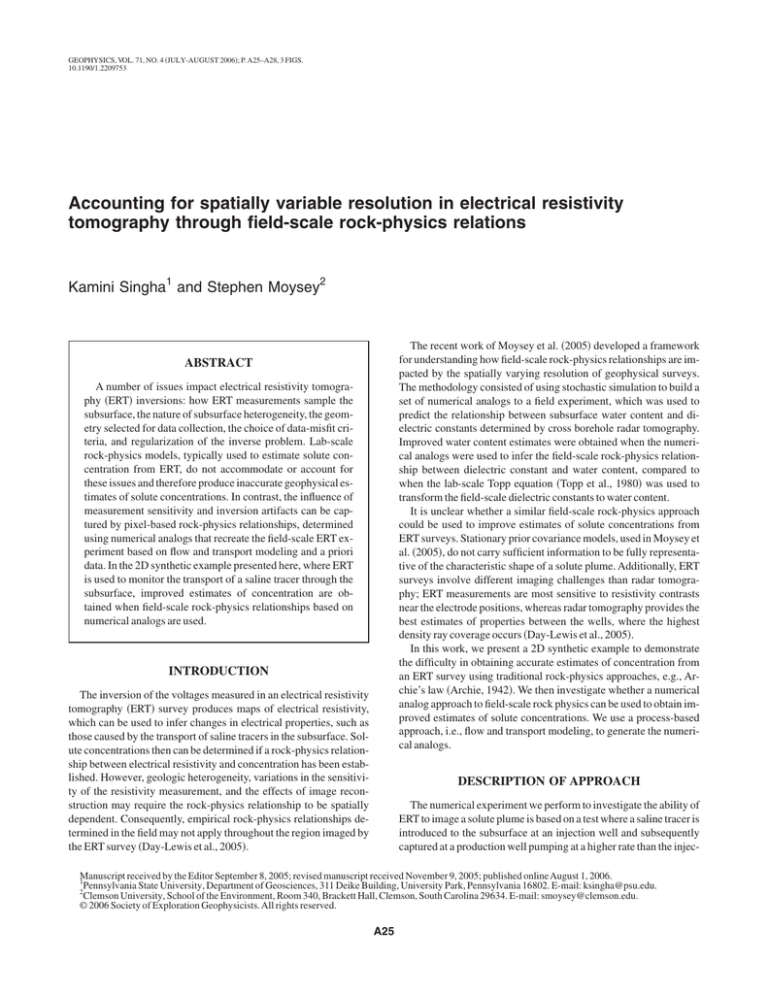
GEOPHYSICS, VOL. 71, NO. 4 共JULY-AUGUST 2006兲; P. A25–A28, 3 FIGS. 10.1190/1.2209753 Accounting for spatially variable resolution in electrical resistivity tomography through field-scale rock-physics relations Kamini Singha1 and Stephen Moysey2 The recent work of Moysey et al. 共2005兲 developed a framework for understanding how field-scale rock-physics relationships are impacted by the spatially varying resolution of geophysical surveys. The methodology consisted of using stochastic simulation to build a set of numerical analogs to a field experiment, which was used to predict the relationship between subsurface water content and dielectric constants determined by cross borehole radar tomography. Improved water content estimates were obtained when the numerical analogs were used to infer the field-scale rock-physics relationship between dielectric constant and water content, compared to when the lab-scale Topp equation 共Topp et al., 1980兲 was used to transform the field-scale dielectric constants to water content. It is unclear whether a similar field-scale rock-physics approach could be used to improve estimates of solute concentrations from ERT surveys. Stationary prior covariance models, used in Moysey et al. 共2005兲, do not carry sufficient information to be fully representative of the characteristic shape of a solute plume. Additionally, ERT surveys involve different imaging challenges than radar tomography; ERT measurements are most sensitive to resistivity contrasts near the electrode positions, whereas radar tomography provides the best estimates of properties between the wells, where the highest density ray coverage occurs 共Day-Lewis et al., 2005兲. In this work, we present a 2D synthetic example to demonstrate the difficulty in obtaining accurate estimates of concentration from an ERT survey using traditional rock-physics approaches, e.g., Archie’s law 共Archie, 1942兲. We then investigate whether a numerical analog approach to field-scale rock physics can be used to obtain improved estimates of solute concentrations. We use a process-based approach, i.e., flow and transport modeling, to generate the numerical analogs. ABSTRACT A number of issues impact electrical resistivity tomography 共ERT兲 inversions: how ERT measurements sample the subsurface, the nature of subsurface heterogeneity, the geometry selected for data collection, the choice of data-misfit criteria, and regularization of the inverse problem. Lab-scale rock-physics models, typically used to estimate solute concentration from ERT, do not accommodate or account for these issues and therefore produce inaccurate geophysical estimates of solute concentrations. In contrast, the influence of measurement sensitivity and inversion artifacts can be captured by pixel-based rock-physics relationships, determined using numerical analogs that recreate the field-scale ERT experiment based on flow and transport modeling and a priori data. In the 2D synthetic example presented here, where ERT is used to monitor the transport of a saline tracer through the subsurface, improved estimates of concentration are obtained when field-scale rock-physics relationships based on numerical analogs are used. INTRODUCTION The inversion of the voltages measured in an electrical resistivity tomography 共ERT兲 survey produces maps of electrical resistivity, which can be used to infer changes in electrical properties, such as those caused by the transport of saline tracers in the subsurface. Solute concentrations then can be determined if a rock-physics relationship between electrical resistivity and concentration has been established. However, geologic heterogeneity, variations in the sensitivity of the resistivity measurement, and the effects of image reconstruction may require the rock-physics relationship to be spatially dependent. Consequently, empirical rock-physics relationships determined in the field may not apply throughout the region imaged by the ERT survey 共Day-Lewis et al., 2005兲. DESCRIPTION OF APPROACH The numerical experiment we perform to investigate the ability of ERT to image a solute plume is based on a test where a saline tracer is introduced to the subsurface at an injection well and subsequently captured at a production well pumping at a higher rate than the injec- Manuscript received by the Editor September 8, 2005; revised manuscript received November 9, 2005; published online August 1, 2006. 1 Pennsylvania State University, Department of Geosciences, 311 Deike Building, University Park, Pennsylvania 16802. E-mail: ksingha@psu.edu. 2 Clemson University, School of the Environment, Room 340, Brackett Hall, Clemson, South Carolina 29634. E-mail: smoysey@clemson.edu. © 2006 Society of Exploration Geophysicists. All rights reserved. A25 A26 Singha and Moysey tion rate. A simple flowchart describing the field-scale rock-physics approach is shown in Figure 1 and will be discussed in more detail later. Overview of the reference case Throughout this paper, reference case refers to the specific set of parameters and modeling choices used to perform the two-well tracer test and determine the resistivity distribution with ERT. To create the reference case, we performed a 3D steady-state, unconfined aquifer-flow simulation with MODFLOW-96 共Harbaugh and McDonald, 1996兲, given a heterogeneous hydraulic conductivity field. An ambient regional hydraulic gradient of 0.001 was set in the model by establishing fixed head boundaries so that flow in Figure 2a is from left to right. All other nonspecified boundaries were treated as zero-gradient. The injection and pumping well were set 10 m apart, Figure 1. Flowchart associated with forming field-scale rock-physics relations. The goal is to produce analog models with concentration plume shapes and magnitudes similar to the true field scenario. Note that standard estimation of concentration from ERT would not use steps 1-5. Instead, the true resistivity map would be converted to an estimate of concentration using a standard lab-scale relationship, like Archie’s law. parallel to the ambient gradient. The hydraulic conductivity field for the reference case was modeled lognormal with a mean of 4.5 m/ day, a variance of ln共K兲 of one, and a spherical variogram 共horizontal range ⫽ 8.4 m, vertical range ⫽ 2.8 m兲. Realizations were created using SGSIM 共Deutsch and Journel, 1992兲. The extraction rate was set to three times the injection rate. Transport was simulated using MT3DMS 共Zheng and Wang, 1999兲, given a constant effective porosity of 0.39. We injected a 2000 mg/L conservative tracer for eight days from 14.75–16.25 m below the surface, followed by the injection of water with a background concentration of 50 mg/L. Concentration boundaries were fixed ⬃100 m from the region with the injection and extraction wells. A 2D ERT experiment was simulated six days after the initial injection. The concentration distribution for the reference case during this time is shown in Figure 2a. Before simulating the ERT survey, solute concentrations were transformed to fluid conductivities 关where 1 mg/L equals 2 mS/cm 共Keller and Frischknecht, 1966兲兴, which were subsequently converted to bulk resistivity using Archie’s law with a formation factor of five, a representative value for porous sand. Note that although this value is assumed to be homogeneous and known in this study, Kemna et al. 共2002兲 have shown that in many cases, changes in bulk electrical conductivity can still be interpreted as an absolute change in concentration in heterogeneous environments. The two ERT wells are positioned 14 m apart with the pumping wells centered between them. Each ERT well is instrumented with 60 electrodes separated by 0.5 m in depth, allowing for collection of 1850 resistance measurements. The resistivity simulations were performed on a nonuniform grid of 50 ⫻ 71 elements, but our analysis focuses on the interior of the mesh where cells are regularly spaced at 0.5 m. Zero-current-flow boundaries were placed 100 m from the subgrid of interest. The ERT inversion routine used for this work is based on Occam’s approach 共Binley, personal communication, 2005兲. The inversion was performed on the same grid used for the forward simulations, without adding measurement noise, including model regularization with a discretized 2D second-derivative operator. Field-scale rock physics Figure 2. 共a兲 The true concentration map produced by flow and transport modeling, 共b兲 the estimated concentration from application of Archie’s law to the inverted ERT tomogram of the true map, 共c兲 the mean of the 50 concentration realizations used to build the concentration-resistivity analog models, and 共d兲 the concentration based on field-scale rock physics 共RP兲. Estimation accuracy of concentrations based on 共e兲 direct application of Archie’s law to the ERT tomogram of the true data, 共f兲 mean of the concentration realizations used for calibration, and 共g兲 field-scale rock physics. The 1:1 line is dashed. Our approach to building field-scale rockphysics relationships relies on the use of numerical analogs of the real field experiment. In this study, the reference case acts as our surrogate for a real-world field experiment. We define an analog as the set of field-scale parameters that are obtained as the result of flow, transport, and ERT forward and inverse simulations. The simulations used to produce the analogs recreate the conditions of the field experiment as closely as possible. Uncertainty in the distribution of subsurface properties is addressed by creating multiple analogs, each having a different hydraulic conductivity distribution. In this study, hydraulic conductivity analogs were created using the same methodology described for the reference case. For the specific example presented in this paper, the procedure for creating the reference case concentration field and resistivity tomogram is repeated 50 times to produce 50 numerical analogs, each Field-scale rock-physics relations for ERT based on a different geostatistical realization of hydraulic conductivity 共Figure 1兲. For every analog, a pair of concentration-resistivity values is formed at each pixel. Over the ensemble of analogs, a set of concentration-resistivity points 共50 in total兲 are obtained and used to fit a linear relationship between the parameters at each spatial location. As a result, over the entire study region we produce 3500 field-scale concentration-resistivity relationships, one for each pixel. Ultimately, this large set of linear relationships determined from the analogs form the rock-physics model we use to convert each pixel in the resistivity tomogram to concentration for the reference case. RESULTS OF 2D SYNTHETIC ESTIMATION The concentration field for the reference case is shown in Figure 2a. In comparison, the concentrations estimated by applying Archie’s law to the resistivity tomogram 共Figure 2b, 2e兲 are significantly lower due to poor sensitivity of the resistance data coupled with the smoothing used in the inversion algorithm. Note that if ERT were able to capture the true resistivity distribution perfectly, Archie’s law would provide an accurate assessment of the concentration. Figure 2c is the mean of the 50 concentration realizations produced to generate the numerical analog models in the field-scale rock-physics approach. This average represents the concentration estimate we might obtain using stochastic flow and transport modeling if we knew the site statistics and the pumping regime. The average also is the concentration map we would obtain using the fieldscale rock-physics approach if the ERT data contained no information. Note that this concentration estimate fails to capture the high and low concentrations 共Figure 2f兲 and is unable to reproduce the specific details of the plume shape. The concentration estimate obtained from the resistivity tomogram using the field-scale rock-physics relationships 共Figure 2d, 2g兲 gives the best match to the true plume shape and concentration magnitudes 共Figure 2a兲, a result that can be quantified by the lower rms error achieved with this technique compared to the other two estimation methods. The field-scale rock-physics estimate of the plume better reproduces the shape of the plume and concentration magnitudes than the estimate obtained by taking the mean of the concentration realizations. However, field-scale rock physics cannot account for all the issues inherent in estimating concentrations based on ERT inversions, particularly if the electrical data hold little information about the evolution of tracer migration through space and time. For example, the spatial sensitivity of ERT is not uniform, so our ability to image a plume depends on the position of the plume in the subsurface. Figure 3a is the diagonal of the model resolution matrix for the initial background conditions; perfectly resolved model parameters take a value of one in this plot. A reduced sensitivity of ERT to parameters in the center of the model is apparent in Figure 3a. The consequences of this spatially varying sensitivity are shown in Figure 3b. The rms error of the concentration estimate is improved only marginally by including ERT data compared to the concentration estimates alone when the plume is located in the center of the model. It is important to note, however, that the field-scale rock-physics estimate and the ensemble mean of the concentration realizations still provide better concentration estimates than those obtained by applying Archie’s law directly to the ERT inversions. A27 DISCUSSION The field-scale rock-physics procedure that we have described provides a method to account for variable measurement sensitivity and the impact of regularization, thereby producing better concentration estimates from ERT compared to those obtained from Archie’s law. In field applications, a priori information to produce the hydraulic conductivity fields can be based on geologists’ renditions of the subsurface, two-point 共or higher order兲 statistics from well data 共Hess et al., 1992兲, cores, outcrop studies, or other geophysical data Rea and Knight et al., 1998. In field studies, the true site statistics are unknown, and therefore many different conceptual models of geologic heterogeneity may need to be considered. Different geologic or experimental scenarios may lead to increased complexity in the rock-physics relationships, thereby precluding the use of a linear relation at each pixel and requiring the inference of posterior probability distribution functions where uncertainty can be quantified. Other considerations complicate field calibration. The impact of errors in field data may be hard to assess, making selection of datamisfit criteria for the inversion of analogs difficult to select. Representing all relevant processes at the field scale, such as surface conductance in the presence of clays, may require explicit modeling. Furthermore, to make quantitative assessments of concentration in the field, 3D ERT data are necessary 共Vanderborght et al., 2005兲. The computational expense of producing the numerical analogs — specifically the inversion of the ERT data — may make this method burdensome for 3D data, considering present computational resources. While we have only shown results for a single example here, this method is flexible and can be used with alternative grid spacings, electrode configurations, and data-collection geometries. The relative degree of improvement will depend on the situation and the pa- Figure 3. 共a兲 Representative diagonal of the resolution matrix from a background inversion. Values of one indicate perfectly resolved model parameters. Resolution is plotted on a log scale and drops dramatically toward the center of the plane, where the model parameters are poorly resolved. Boreholes are outlined in black. 共b兲 The relative value of the ERT data for estimating concentrations is a function of the distance of the plume from the center of the array 共an area of poor sensitivity兲. The plotted rms⫽error ratio is obtained by dividing the rms error for the mean of the concentration realizations by the rms error of the concentration estimates obtained using ERT in conjunction with field-scale rock physics. An rms-error ratio of 1 indicates that the ERT data contain no additional information regarding the plume concentrations compared to the flow and transport simulations. Values greater than one indicate that field-scale rock physics improve the estimation of the plume concentrations. The dotted line in 3a corresponds to the same location in 3b. A28 Singha and Moysey rameters involved. A number of factors control how well field-scale rock physics performs, including the sensitivity of inverted resistivities to ERT data, the accuracy of the realizations used in the simulations, and the geometry used for data collection. In cases where the geophysical information from ERT is noninformative, field-scale rock physics cannot improve the concentration magnitudes beyond what information is provided through transport simulation. Additionally, poor estimates of site hydrogeology, which are used to build the analog models, may lead to inaccuracies regarding the location and magnitude of the tracer plume. We note that greater agreement between resistivities measured in the lab and field can be attained by making improvements to ERT inversion strategies. Ultimately, the improvements in ERT inversion should enhance the accuracy of concentration estimates regardless of the rock-physics approach applied. The advantage of the fieldscale rock-physics approach is that it allows for quantitative assessment of the degree to which lab- or core-scale rock-physics information is transferable between scales and provides a practical mechanism for dealing with these scale changes. CONCLUSION We have provided a method to better estimate tracer concentrations from ERT data. This approach also allows us to integrate our knowledge of site hydrogeology and the effects of spatially varying resolution in the tomogram to correct for inversion artifacts and the sensitivity of ERT measurements. We have shown that, for the example discussed in this paper, the field-scale rock-physics approach was able to produce more accurate tracer concentrations from ERT than traditional rock-physics techniques. Continued research will allow us to better quantify the impact of alternative geologic and experimental scenarios on this method and assess the viability of its application to field data. ACKNOWLEDGMENTS The authors thank Andrew Binley of Lancaster University for use of his ERT inversion code. This material is based upon work supported by the National Science Foundation under Grants No. EAR-0124262 and EAR-0229896. REFERENCES Archie, G. E., 1942, The electrical resistivity log as an aid in determining some reservoir characteristics: Transactions of the American Institute of Mining, Metallurgical and Petroleum Engineers, 146, 54–62. Day-Lewis, F. D., K. Singha, and A. M. Binley, 2005, Applying petrophysical models to radar traveltime and electrical-resistivity tomograms: Resolution-dependent limitations: Journal of Geophysical Research, 110, B08206. http://dx.doi.org/08210.01029/02004JB003569. Deutsch, C. V., and A. G. Journel, 1992, GSLIB: Geostatistical Software Library and User’s Guide: Oxford University Press, Inc. Harbaugh, A. W., and M. G. McDonald, 1996, User’s documentation for MODFLOW-96, an update to the U. S. Geological Survey Modular FiniteDifference Ground-Water Flow Model. Hess, K. M., S. H. Wolf, and M. A. Celia, 1992, Large-scale natural gradient tracer test in sand and gravel, Cape Cod, Massachusetts, 3, Hydraulic conductivity variability and calculated macrodispersivities: Water Resources Research, 28, 2011–2027. Keller, G. V., and F. C. Frischknecht, 1966, Electrical methods in geophysical prospecting: Pergamon Press, Inc. Kemna, A. , J. Vanderborght, B. Kulessa, and H. Vereekenght, 2002, Imaging and characterisation of subsurface solute transport using electrical resistivity tomography 共ERT兲 and equivalent transport models: Journal of Hydrology, 267, 125–146. Moysey, S., K. Singha, and R. Knight, 2005, A framework for inferring fieldscale rock physics relationships through numerical simulation: Geophysical Research Letters, 32, L08304. http://dx.doi.org/08310.01029/ 02004GL022152. Rea, J., and R. Knight, 1998, Geostatistical analysis of ground-penetrating radar data: A means of describing spatial variation in the subsurface: Water Resource Research, 34, 329–339. Topp, G. C., J. L. Davis, and A. P. Annan, 1980, Electromagnetic determination of soil water content: Measurements in coaxial transmission lines: Water Resource Research, 16, 574–582. Vanderborght, J., A. Kemna, H. Hardelauf, and H. Vereecken, 2005, Potential of electrical resistivity tomography to infer aquifer transport characteristics from tracer studies: A synthetic case study: Water Resource Research, 41, W06013. http://dx.doi.org/10.1029/2004WR003774. Zheng, C., and P. P. Wang, 1999, MT3DMS: A modular three-dimensional multispecies model for simulation of advection, dispersion and chemical reactions of contaminants in groundwater systems; documentation and user’s guide: U. S. Army Engineer Research and Development Center.
